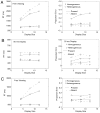Information-limited parallel processing in difficult heterogeneous covert visual search
- PMID: 20873936
- PMCID: PMC3929106
- DOI: 10.1037/a0020366
Information-limited parallel processing in difficult heterogeneous covert visual search
Abstract
Difficult visual search is often attributed to time-limited serial attention operations, although neural computations in the early visual system are parallel. Using probabilistic search models (Dosher, Han, & Lu, 2004) and a full time-course analysis of the dynamics of covert visual search, we distinguish unlimited capacity parallel versus serial search mechanisms. Performance is measured for difficult and error-prone searches among heterogeneous background elements and for easy and accurate searches among homogeneous background elements. Contrary to the claims of time-limited serial attention, searches in heterogeneous backgrounds instead exhibited nearly identical search dynamics for display sizes up to 12 items. A review and new analyses indicate that most difficult as well as easy visual searches operate as an unlimited-capacity parallel analysis over the visual field within a single eye fixation, which suggests limitations in the availability of information, not temporal bottlenecks in analysis or comparison. Serial properties likely reflect overt attention expressed in eye movements.
(PsycINFO Database Record (c) 2010 APA, all rights reserved).
Figures








References
-
- Allen HA, Humphreys GW. A psychophysical investigation into the preview benefit in visual search. Vision Research. 2007;47:735–745. - PubMed
-
- Carrasco M, Evert DlL, Chang I, Katz SM. The eccentricity effect: Target eccentricity affects performance on conjunction searches. Perception and Psychophysics. 1995;57:1241–1261. - PubMed
-
- Carrasco M, Frieder KS. Cortical magnification neutralizes the eccentricity effect in visual search. Vision Research. 1997;37:63–82. - PubMed
-
- Carrasco M, McLean TL, Katz SM, Frieder KS. Feature asymmetries in visual search: Effects of display duration, target eccentricity, orientation and spatial frequency. Vision Research. 1998;38:347–374. - PubMed
-
- Cave KR, Wolfe JM. Modeling the role of parallel processing in visual search. Cognitive Psychology. 1990;22:225–271. - PubMed
Publication types
MeSH terms
Grants and funding
LinkOut - more resources
Full Text Sources
Miscellaneous

